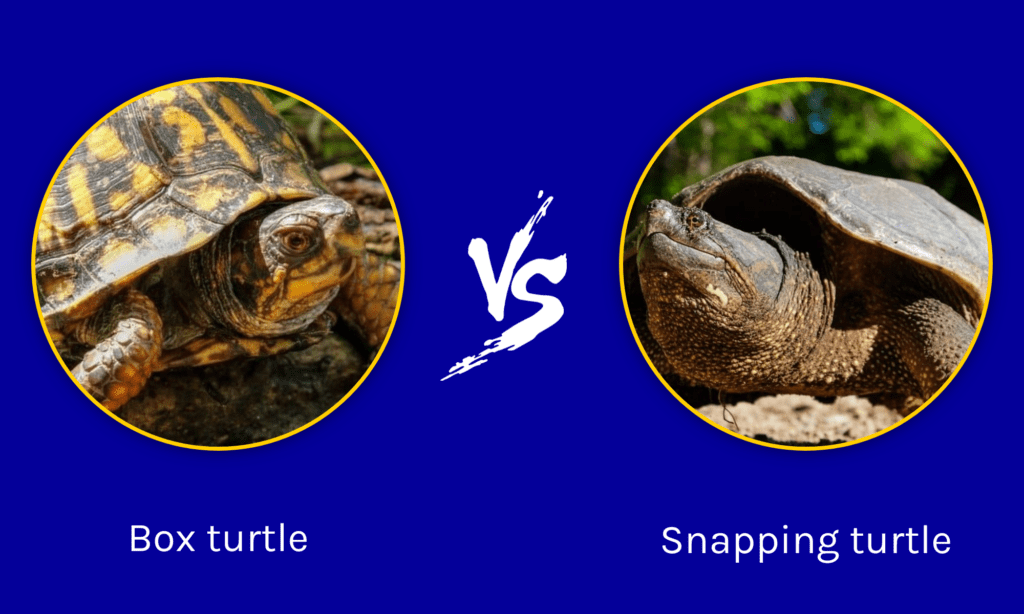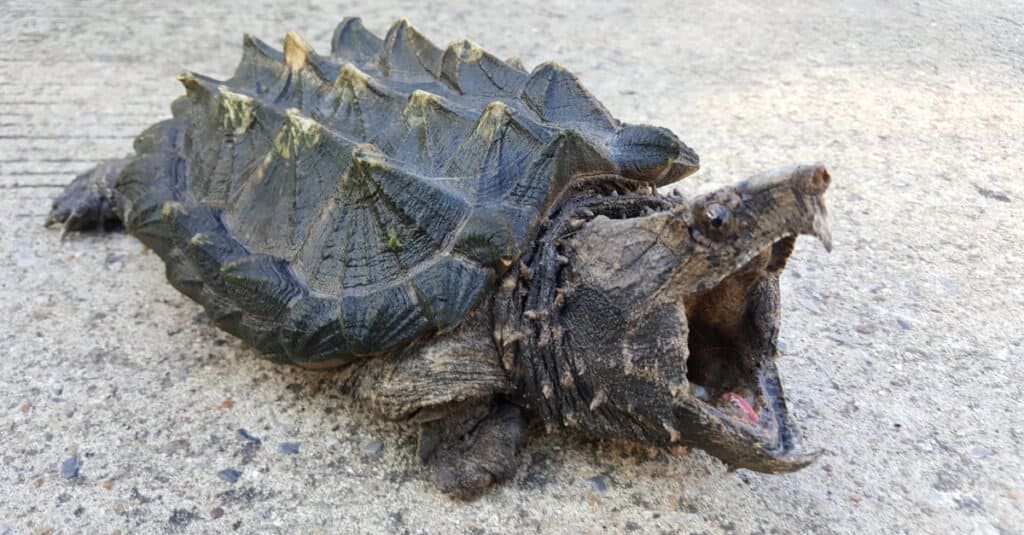The box turtle and snapping turtle have a lot in common, but these two reptiles are incredibly different! Despite both of them being turtles, they live in different habitats, eat different things, and have wildly different demeanors. Today, we are going to take a look at both of them to see what makes them unique. Let’s compare: Box Turtle vs Snapping Turtle; what makes them different?
Comparing a box turtle and a snapping turtle
CAPTION: Box turtles are terrestrial turtles that can hide in their shells. Snapping turtles are large aquatic turtles that often hunt small creatures.

| Box turtle | Snapping turtle | |
|---|---|---|
| Taxonomy | Family: Emydidae Genus: Terrapene | Family: Chelydridae Genus: Chelydra |
| Size | Weight: 0.5-2 lbs | Weight: 10-35 lbs |
| Appearance | Domed shell with patterned shells. Legs with small claws. Hinged shell opening. s | Smooth, rounded shells. Highly mobile in the water. Long, serpentine neck. |
| Habitat | Terrestrial turtle. | Aquatic turtle. |
| Distribution | Widely distributed across the United States and Mexico. | Most of the United States, excluding the West Coast and desert regions. |
| Diet | Omnivores. Mostly vegetation, but often eats insects. | Omnivores. Aquatic vegetation and small animals. |
The 6 main differences between a Box Turtle and a Snapping Turtle
The main differences between a box turtle and a snapping turtle are that box turtles are terrestrial, can hide in their shells, and eat vegetation and insects. Snapping turtles are aquatic, can’t fully retract into their shells, and eat small animals and aquatic vegetation.
Although both the box and snapping turtles are “turtles,” they actually belong to quite different scientific categories. The box turtle belongs to the Emydidae family, otherwise known as pond turtles. More specifically, the box turtle belongs to the Terrapene genus. Terrapenes include all species of box turtles, a group of turtles that resemble tortoises but aren’t closely related to them. Box turtles live on land, despite being classified as “pond turtles.” Snapping turtles are aquatic turtles that belong to the Chelydridae family, a group that includes all of the snapping turtles across the world.
Although both are considered turtles, they have evolved quite differently. The box turtle is a land-dwelling turtle that can’t swim. Additionally, they can fully retract into their shells and close them, providing excellent protection. Snapping turtles are adapted for aquatic life and can pull their necks under their shells but can’t fully hide their heads as the box can.
Let’s take a closer look at these turtles and learn more about their differences.
Box Turtle vs Snapping Turtle: Taxonomy

Box turtles are members of the
Terrapenegenus.
©iStock.com/SteveByland
Both the box and snapping turtles are turtles, but they aren’t all that related. Box turtles belong to the Terrapene genus under the Emydidae family. Terrapenes are almost exclusively found in the Americas, save for two species in Asia. There are six species of Terrapene, with the most common being the common box turtle (the Carolina box turtle). Within each species, there are multiple subspecies, about 12 in total.
There are a few types of snapping turtles, but the most common is the common snapping turtle. Common snapping turtles belong to the Chelydridae family and are among the two extant genera within the family. Within the family, common snappers belong to the Chelydra genus, of which there are three species.
Box Turtle vs Snapping Turtle: Size

Snapping turtles are significantly larger than box turtles.
©Tyler Clemons/Shutterstock.com
The common box turtle is a relatively small turtle. On average, it is less than a foot long and only weighs between 0.5 and 2 lbs. Due to its small size, it is often kept as pet and can live for an extremely long time.
Snapping turtles are among the largest freshwater turtles around. The largest of all snapping turtles is the alligator snapping turtle, the largest on record, weighing 403 lbs. The common snapping turtle, however, usually weighs between 10 and 35 lbs.
Box Turtle vs Snapping Turtle: Appearance

Box turtles are small and have heavily patterned shells.
©Lisa Holder/Shutterstock.com
All box turtles have a slightly different appearance, but most are easy to identify. They are small turtles that closely resemble tortoises. Their shells are high arches, smooth, and have intricate patterns across them. As they are terrestrial, their legs are short and stocky with small claws.
Snapping turtles are large turtles with round shells and webbed legs to swim better. Alligator snappers have thick ridges on their backs, while common snappers have smooth, round shells. When extended, their necks are serpentine and long.
Box Turtle vs Snapping Turtle: Habitat

Snapping turtles live in streams, rivers, lakes, and ponds.
©iStock.com/looderoo
Sadly, the misunderstanding of box turtle habitats has resulted in their death many a time. Box turtles cannot swim and do not live in the water. Humans often “return” them to the water when found, almost certainly killing them. Box turtles live in an array of habitats, including forests, deserts, grassy regions, and more.
Snapping turtles are aquatic turtles that live in river systems, streams, ponds, lakes, and more.
Box Turtle vs Snapping Turtle: Distribution

Both box turtles and snapping turtles live across most of the United States.
©Jessica Baldwin/Shutterstock.com
The different species of box turtles live across most of the United States and into Mexico. The eastern box turtle is the most common and lives along the east coast, from Maine to Florida and as far west as Mississippi.
The common snapping turtle has the widest distribution of the snapping turtles. They can be found throughout most of the United States, about as far west as Idaho.
Box Turtle vs Snapping Turtle: Diet

Snapping turtles eat fish, frogs, lizards, and more.
©Sista Vongjintanaruks/Shutterstock.com
The box turtle is an omnivore but gets most of its food from vegetation. Besides vegetation, it will eat almost anything they come across that is small enough to swallow. Most of its prey include small insects and invertebrates like slugs and worms.
Snapping turtles are also omnivorous, but their size allows them to prey on larger creatures. Much of their diet comes from aquatic vegetation, but their diet also includes fish, lizards, frogs, insects, and baby waterfowl.
The photo featured at the top of this post is © outdoorsports44/Shutterstock.com
Thank you for reading! Have some feedback for us? Contact the AZ Animals editorial team.






